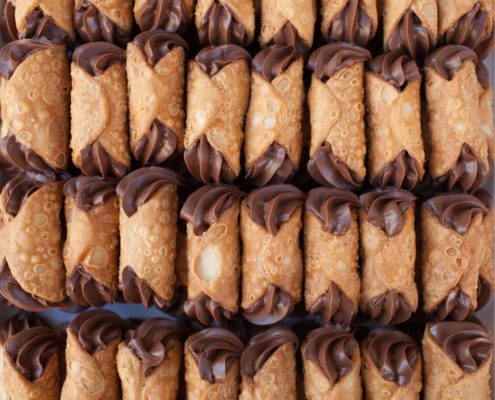Dominique Rizzo | Bespoke Food Tours
Shell Ingredients
- 3 cups plain flour
- 1/4 cups sugar
- 1/4 tsp cinnamon
- 3 tblsp butter
- 1 egg
- 1 egg yolk
- 1/2 cup white wine
- 1 tblsp white vinegar
- 2 tblsp water
- 1 egg for egg wash
- Abundant oil for frying
Filling Ingredients
- 1lt milk
- 250g dark chocolate
- 1 1/4 cups granulated sugar
- 6 eggs
- 1/2 cup cocoa
- 3/4 cup plain flour flour or 1/2 cup cornstarch/rice flour or potato starch
- 1/2 tsp cinnamon ( optional)
Recipe Steps
For the cannoli shells – In a food processor combine the flour, sugar, cinnamon and butter until crumbly – about 1 minute. Combine the egg, egg yolk, wine, vinegar and the water, pour this into the flour mix and combine until it forms a dough. Tip the dough out onto a table or bench top and knead until smooth – approximately 5-10 minutes. When smooth, flatten slightly to form a disk and wrap with plastic wrap. Rest in the fridge for about 1 hour.
Meanwhile while the dough is resting make the filling by warming the milk with the chocolate, cinnamon in a heavy based saucepan over a low heat.
With your beaters, combine the eggs and the sugar until pale and thick and fluffy, add in the cocoa powder and the flour and mix until blended. Pour a little of the warm milk into the bowl with the eggs and flour and whisk gently to combine. Then pour all of the mixture back into the saucepan with the remainder of the milk and place over a moderate heat.
Whisk continually over a moderate heat until the custard starts to thicken, continue to whisk vigorously so as not to form any lumps and cook the custard for another 5-10 minutes until all of the flavour of the flour has been cooked out and the custard is a thick consistency. Pour the custard into a bowl and cover with cling film ontop of the custard so as not to form a skin. Allow the custard to completely cool before piping. – You may need to whip the custard with beaters to smooth it out when it comes out of the fridge.
Cut the dough into smaller sections and using your pasta machine or a rolling pin, roll the dough out into a sheet about an eighth of an inch (2-3 mm) thick, and cut it into either 4-inch (10 cm) diameter disks, or squares that are about 3 1/2 inches a side.
You will either need to purchase the cannoli metal tubes which can be bought from any kitchenware shop or on line, or you can use pieces of timber dowel cut into lengths of about 15cm . The timber dowel will need to be submerged into hot oil and cooked or cured so to speak which helps the pastry not to stick to the timber.
Using a cutter or cutting the shapes yourself, you then wrap the pastry around the moulds, ensuring your stick the pastry down with egg wash. Ideally you want the openings of the cannoli to be sitting the same and for all the cannoli to have the same shape. Prior to deep frying.
Depending on how many cannoli moulds you have will depend on how many you can make at once.
The shells themselves will keep for a couple of weeks in an airtight container, the dough will keep in the fridge for a few weeks and of course you can freeze the cooked cannoli shells but you will have to eat them straight away once defrosted.
While you are rolling the pastry around the moulds the oil should be heating; when it reaches about 185 C, begin frying the shells, 2-3 at a time so as not to chill the oil; the frying will take 4-5 minutes, by which time the pastry will turn a pretty mahogany golden colour both inside and out. You will need to surn the moulds so that you get an even colouring on all sides. If you are using timber dowel you will need to remove the timber dowel from the cooked cannoli and then place the cannoli shells back into the fryer to golden on the inside as the cases may not cook all the way through.
Once you have fried the shells, remove the shells from the oil and drain them on absorbent paper, when ok to handle, gently twist the shell from the tube, set the shell aside and continue to roll and fry the shells.
Traditionally the shells will be blistered and bubbled which is part of the fermentation process and caused from the addition of the wine and vinegar. These bubbles are iconically Sicilian. Once all the shells have cooled. Place the smooth whipped custard into a piping bag and pipe the shells from each side ensuring you fill them right from the centre. Dust heavily with icing sugar and serve. Once filled the cannoli will only last a few hours before they start to go soft.


